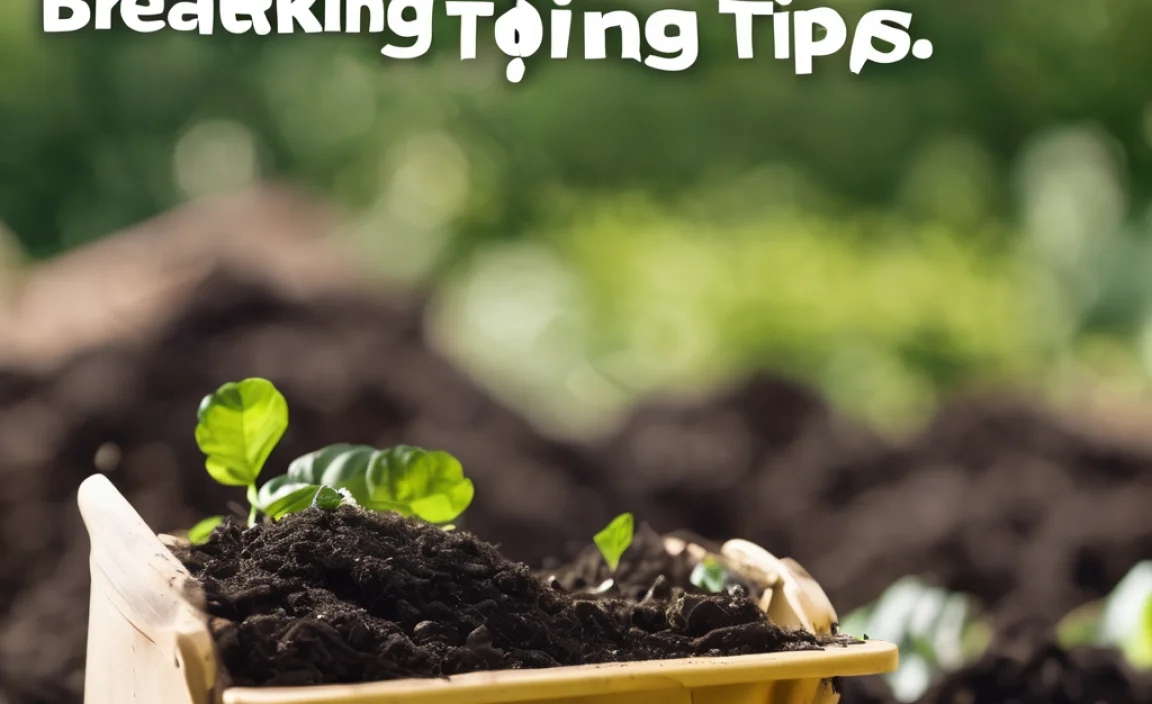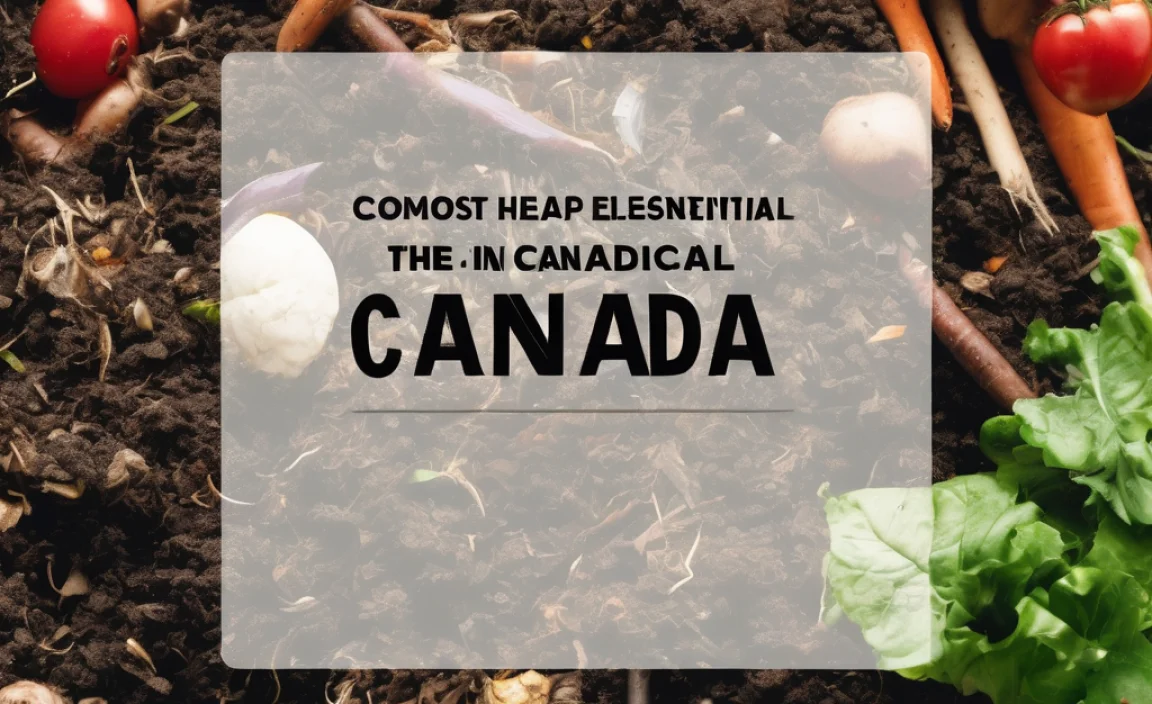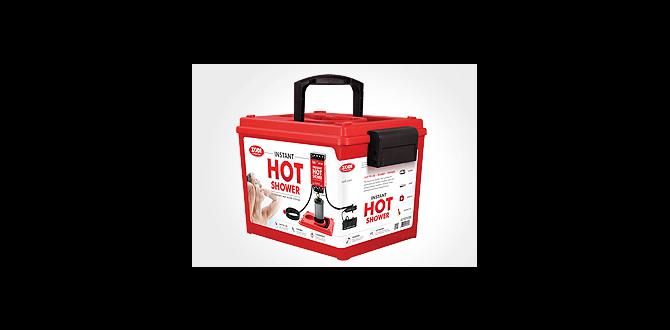“`html
Compost Enzymes Comparison: Your Essential Beginner’s Guide
Ever feel like your compost pile is taking its sweet time? You’ve added your greens and browns, followed the tips, but it’s still just… sitting there. It can be frustrating when you’re eager to get that nutrient-rich soil for your garden. But what if I told you there’s a secret weapon to speed things up? That’s where compost enzymes come in!
Don’t worry if “enzymes” sounds a bit too science-y. Think of them like tiny helpers that break down your kitchen scraps and yard waste much faster. In this guide, we’ll break down what compost enzymes are all about, the different types you can use, and how to choose the best ones to get your compost cooking. We’ll make this easy, so you can get back to the fun part: gardening!
Ready to turn up the heat on your compost pile? Let’s dig in!
What Exactly Are Compost Enzymes?
Imagine you’re trying to eat a big, tough steak. You could chew on it forever, or you could use a tenderizer to make it easier to break down. Compost enzymes are kind of like nature’s tenderizer for your compost pile. They are natural proteins produced by microorganisms – like bacteria and fungi – that speed up the decomposition process.
Your compost pile is a busy ecosystem. When you add organic materials like fruit peels, coffee grounds, and leaves, these tiny organisms get to work. They eat the waste and, in the process, release enzymes. These enzymes act as catalysts, breaking down large, complex organic molecules into smaller, simpler ones. This makes it easier for the microorganisms to digest the material, leading to faster composting.
Without enough of the right enzymes, or if the conditions aren’t right for the microbes that produce them, your compost pile can decompose very slowly. This is where adding commercial compost enzyme products can really help, especially for beginners or those looking for a quicker turnaround.
Why Use Compost Enzymes?
Using compost enzymes isn’t strictly mandatory for composting to happen – nature will eventually do its thing. However, they offer some fantastic benefits that can make your composting journey smoother and more rewarding:
- Faster Decomposition: This is the big one! Enzymes significantly speed up the breakdown of organic materials, turning your waste into usable compost in a much shorter time.
- Reduced Odor: A healthy, fast-decomposing compost pile often produces less undesirable odor because the food scraps are being processed efficiently rather than sitting and rotting.
- Improved Aeration: As materials break down faster, the pile can become more porous, allowing better air circulation. Good airflow is crucial for aerobic decomposition (the kind that doesn’t stink!).
- Breaks Down Stubborn Materials: Some materials, like woody stems or tougher yard waste, can take a long time to break down. Enzymes help tackle these tougher bits.
- More Consistent Results: For beginners, maintaining the perfect balance of “greens” and “browns,” moisture, and aeration can be tricky. Enzyme activators can provide a helpful boost to ensure your pile breaks down efficiently, regardless of minor imbalances.
- Boost for Microorganisms: While enzymes are released by microbes, some products also contain beneficial microbes themselves, giving your compost ecosystem a supercharged start.
Think of it this way: while a compost pile can eventually become compost on its own, adding enzymes is like giving your pile a personal trainer and a nutrient boost. It helps everything work better and faster.
Types of Compost Enzymes
When you start looking into compost enzyme products, you might notice they often fall into a couple of main categories, or sometimes a combination of both:
1. Enzyme Activators
These products primarily focus on providing the enzymes that accelerate the breakdown of organic matter. They essentially give the existing microorganisms in your pile a helping hand, or they might introduce readily active enzymes that start working immediately.
Key characteristics:
- Often derived from biological sources or created through fermentation processes.
- Target the breaking down of complex organic molecules like proteins, fats, and carbohydrates.
- Can be in liquid or powder form.
2. Microbial Inoculants (with Enzymes)
These products contain not only enzymes but also a blend of beneficial microorganisms, such as bacteria and fungi. The idea here is to introduce a diverse and robust population of microbes that are excellent decomposers. These microbes then produce their own enzymes, effectively kickstarting and sustaining the decomposition process.
Key characteristics:
- Contain live or dormant microorganisms.
- May also contain nutrients or stimulants to help the microbes thrive.
- Often more effective in piles that might be lacking in beneficial microbial activity.
- Can come as powders, liquids, or even small granules.
Many commercially available “compost activators” or “compost starters” are actually a blend of both enzyme activators and microbial inoculants. This approach offers a dual benefit: immediate enzymatic action and long-term microbial support.
Key Enzymes to Look For (and What They Do)
While most products list “enzymes” generally, understanding a few key ones can help you appreciate what’s happening in your compost pile. These are the workhorses of decomposition:
When microbes break down organic matter, they primarily target the big components: cellulose, hemicellulose, lignin, proteins, and fats. Different enzymes specialize in breaking these down:
- Cellulases: Break down cellulose. Cellulose is a major component of plant cell walls, making it abundant in things like grass clippings, leaves, and paper. This is a crucial enzyme for decomposing plant-based materials.
- Amylases: Break down starches. Starches are found in many food scraps, like vegetable peels and grains.
- Proteases: Break down proteins. Proteins are found in nitrogen-rich “green” materials like grass clippings, food scraps (especially meat and dairy, though these are often best avoided in home compost), and manure.
- Lipases: Break down fats and oils. Similar to proteins, fats are found in food scraps and can contribute to faster breakdown.
- Ligninases: Break down lignin. Lignin is a complex polymer found in woody plant material. It’s one of the toughest components to decompose, and enzymes that target lignin are essential for breaking down tougher yard waste like twigs and bark much faster.
Many compost activators will boast about having a broad spectrum of these enzymes or a high concentration of specific ones that target common composting materials. For a beginner’s compost pile, you’re generally looking for a product that covers the breakdown of cellulose and starches effectively, as these are the most abundant in typical kitchen and yard waste.
How to Compare Compost Enzyme Products
Navigating the world of compost activators can seem a bit overwhelming at first, but by focusing on a few key factors, you can make a smart choice for your composting needs. Here’s a breakdown of what to consider:
1. Ingredients and Formulation
Look at what the product actually contains. Is it:
- Purely Enzyme-Based: Focuses on delivering specific enzymes like cellulases, proteases, etc.
- Microbial Blend: Primarily introduces a mix of beneficial bacteria and fungi.
- Combined Formula: Offers both enzymes and a microbial starter.
For most beginners, a combined formula often provides the best all-around boost. Check the label for any specific enzymes mentioned or the types of microbes included. Some products might also include trace minerals or nutrients that help the microbes thrive.
2. Form (Liquid, Powder, Granules)
Compost activators come in different forms, and each has its pros and cons:
- Liquid: Easy to measure and mix with water. Can disperse quickly throughout the pile. May have a shorter shelf life.
- Powder: Generally stable and has a good shelf life. Needs to be dissolved in water or sprinkled evenly. Can be a bit messier to handle.
- Granules: Easy to sprinkle evenly. Can sometimes clump.
Your preference for ease of use or storage might guide this choice. Liquid and powder forms are very common and effective.
3. Application Instructions and Ease of Use
How do you use it? Most products recommend adding a certain amount per layer of compost material, or a specific amount per cubic foot/yard of compost. Look for clear, simple instructions. If a product requires complex mixing or exact measurements that are hard to achieve, it might be less beginner-friendly.
4. Manufacturer Reputation and Reviews
What are other gardeners saying? Check online reviews for products. Reputable brands often invest in research and development and provide consistent quality. Look for reviews that mention speed of composting, odor reduction, and ease of use.
5. Price and Size
Compost activators come in various sizes, from small bottles to large bags. Compare the cost per use or per cubic foot of compost. A larger initial investment in a concentrated product might end up being more economical if you have a large compost pile or plan to compost regularly.
6. Target Audience/Purpose
Some products are designed for general composting, while others might be specialized for things like pet waste composting or specific types of yard waste. For a typical home compost pile with kitchen scraps and yard trimmings, a general-purpose activator is usually best.
Compost Enzyme Products at a Glance
To give you a clearer picture, let’s look at some typical types of compost enzyme products you might encounter. Keep in mind that this isn’t an exhaustive list, and product formulations can change, but it covers the common categories.
Here’s a comparison table to help you visualize the differences:
| Product Type | Primary Function | Key Components | Pros | Cons | Best For |
|---|---|---|---|---|---|
| General Enzyme Activator | Speeds up breakdown of organic matter. | Broad spectrum of enzymes (cellulases, proteases, etc.). Sometimes includes mild stimulants. | Quick initial boost, effective on common materials, generally fast-acting. | May not introduce fresh microbial diversity, effectiveness can wane without sustained microbe population. | Beginner composters wanting to speed up their pile, existing piles that are slow. |
| Microbial Inoculant (Compost Starter) | Introduces beneficial bacteria and fungi to kickstart decomposition. | Concentrated strains of specific or diverse microorganisms. May include nutrients for microbes. | Builds a robust compost ecosystem, good for establishing new piles, can help handle a wider range of materials. | Takes a bit longer to see full effects as microbes need to multiply, effectiveness depends on existing pile conditions (moisture, aeration). | New compost piles, improving slow or stagnant piles by adding microbial life. |
| Combined Enzyme & Microbial Formula | Provides immediate enzymatic action and establishes a strong microbial colony. | Combination of enzymes and diverse beneficial microorganisms. | Fast start with sustained breakdown, dual-action benefits, often very effective for general composting. | Can be slightly more expensive than single-function products. | Most home composters, all types of compost piles, for optimal speed and efficiency. |
| Specialty (e.g., Odor Control, Pet Waste) | Targets specific composting issues or waste types. | Enzymes and microbes optimized for breaking down specific compounds (e.g., ammonia for odor), or for handling pathogens in pet waste. | Highly effective for niche problems, can be very efficient for their intended purpose. | May be overkill or less effective for general composting, can be more expensive. | Composters dealing with persistent odors, or those composting pet waste (follow specific safety guidelines). |
How to Use Compost Enzymes Effectively
Just getting a compost activator is half the battle. Using it correctly ensures you get the most bang for your buck and the fastest compost!
1. Read the Label Carefully
This is the golden rule! Every product is different. The manufacturer’s instructions are your best guide. They’ll tell you the correct dosage, how often to apply it, and the best way to mix it.
2. Prepare Your Activator (If Necessary)
Many liquid or powder activators need to be diluted in water. Use a watering can with a gentle spray. The amount of water usually isn’t critical, but you want to ensure it’s properly dispersed. Some instructions might suggest using lukewarm water, as it can help activate dormant microbes.
3. Apply During Layering or Turning
The best time to add your prepared activator is:
- When adding new material: As you add layers of fresh kitchen scraps or yard waste, lightly sprinkle or spray the activator over the new material. This ensures the enzymes and microbes get to work right away on the fresh stuff.
- During turning: If you turn or mix your compost pile, this is another great opportunity. Apply the activator after you’ve mixed everything to distribute it evenly throughout the pile.
Avoid dumping the whole batch in one spot. Even distribution is key.
4. Ensure Proper Moisture Levels
Enzymes and microbes need moisture to be active. Your compost pile should feel like a wrung-out sponge – damp but not soaking wet. If your pile is too dry, the activator won’t work effectively, and your decomposition will slow down. If it’s too wet, you risk anaerobic conditions and foul odors.
5. Maintain Aeration
Compost enzymes and microbes work best in an aerobic environment (with oxygen). Turning your compost pile regularly (every 1-2 weeks is often recommended) ensures that air can reach all parts of the pile. This helps the microbes, prevents them from dying off, and keeps odors down.
6. Be Patient (Even Sooner!)
Even with activators, composting takes time. However, you should notice a difference. Your pile might heat up more quickly, materials might disappear faster, and it might smell earthier. A typical hot compost pile can produce finished compost in 1-3 months, while a quicker cold pile might take 6 months to a year. Enzymes help push things towards the faster end of that spectrum.
When Might You NOT Need Compost Enzymes?
While compost enzymes and activators are fantastic tools, they aren’t always necessary. Your compost pile might be doing just fine on its own if:
- You have a well-established compost system: If you’ve been composting for a while and have a good understanding of balancing greens and browns, maintaining moisture, and aerating, your pile likely has a healthy, active microbial population producing plenty of its own enzymes.
- You regularly add “activators” instinctively: If you frequently add fresh, nitrogen-rich materials (like grass clippings or coffee grounds) to your pile, you’re essentially feeding the microbes and encouraging enzyme production.
- You’re not in a hurry: Composting is a natural process. If you have the space and time and don’t mind a slower decomposition rate, your pile will eventually break down without any additives.
- You have a very simple system: A basic bin with kitchen scraps and leaves that you only turn occasionally might decompose slowly, but adding activators might not be worth the cost if you are not aiming for rapid results.
Think of enzymes as a helpful nudge, not a required component for all composting success. If your pile is working well, leave it be!
Composting with and without Enzymes: A Practical Look
Let’s paint a picture of what composting might look like with and without an enzyme activator.
Scenario A: Composting Without Dedicated Enzyme Products
Meet Sarah. She’s new to composting and sets up a simple bin. She adds her kitchen scraps (apple cores, coffee grounds, banana peels) and mixes them with fallen leaves from her yard. She waters the pile when it looks dry.
- Initial Phase: Sarah adds layers over a few weeks. The pile slowly starts to break down. She notices some materials are decomposing, but others, like tough carrot tops, seem to just sit there.
- Mid-Stage: After a couple of months, the bottom layers have become darker and more crumbly, but the top is still a mix of recognizable scraps. The pile might have a slightly “sour” smell if the greens and browns aren’t perfectly balanced or if it’s too wet.
- End Stage: Six months to a year later, the pile eventually turns into dark, rich compost. However, some harder materials like small twigs might still be present and require further breakdown.
Outcome: Sarah successfully makes compost, but it takes longer. She learns a lot through trial and error about balancing materials and moisture.
Scenario B: Composting with a Combined Enzyme & Microbial Activator
Meet Tom. He’s also new

I am passionate about home engineering. I specialize in designing, installing, and maintaining heating, ventilation, and air conditioning systems. My goal is to help people stay comfortable in their homes all year long.



